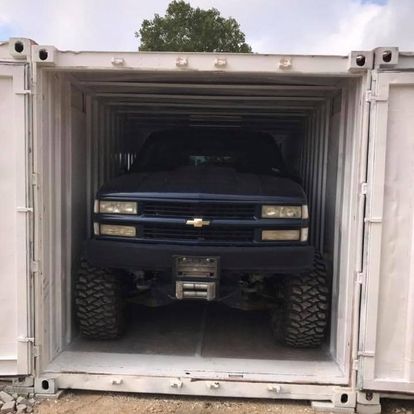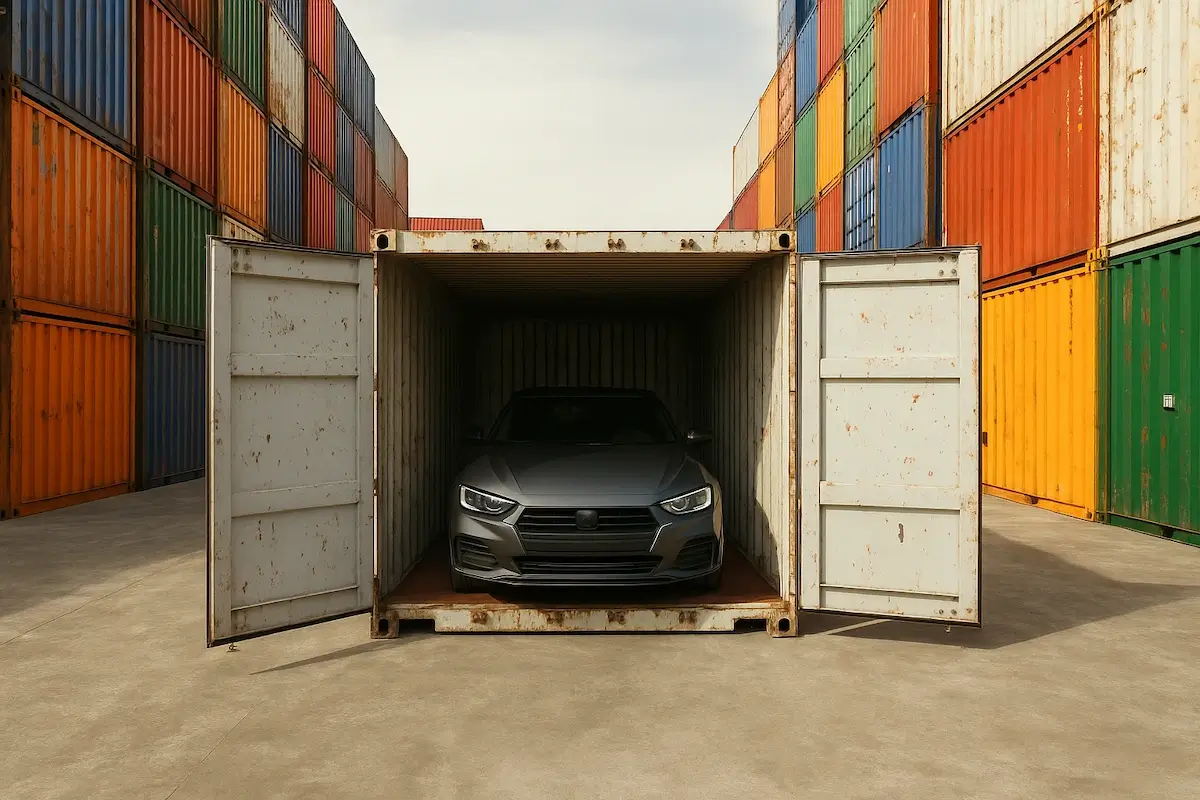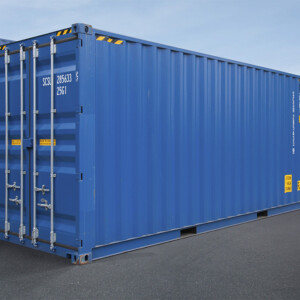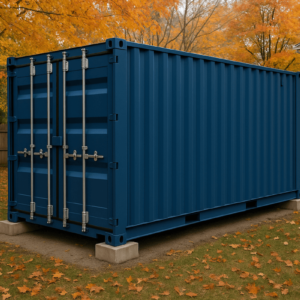Tired of stressing over where to keep your car safe?
Shipping container car storage might be your new favorite hack. It’s affordable car storage, super secure, and doesn’t require building a whole garage from scratch. Just drop it on your property, and boom, you’ve got weatherproof, theft-resistant car storage that holds up year-round. Great if you’re looking to free up garage space or skip the hassle of a garage conversion.
Here’s why people are loving it:
- It handles rain, wind, pests, and nosy neighbors like a champ.
- You can store one or multiple vehicles, depending on the size.
- Moving? No problem. These things are portable, take them with you.
- Want to customize it? Add ramps, insulation, or side doors to make it your own.
We’ve seen folks use containers for everything from temporary storage to protecting their weekend ride during the off-season. Whether you’re after something short-term or a long-haul solution, it’s a smart setup that gives you flexibility and peace of mind.
Want to see how it works? Here’s your guide to using shipping containers for car storage.
Advantages of Using Shipping Containers for Car Storage
Shipping containers provide a solid, practical solution for storing vehicles. They offer protection against weather and theft, save money over long-term use, can be moved according to needs, and adapt to different storage requirements through customization.
Durability & Security
Shipping containers are built like tanks, with thick steel, weather-resistant, and tough to break into. Add a solid lock, and you’ve got a storage space that keeps out thieves, pests, and the elements. Whether you go with a new shipping container or used shipping, both offer reliable protection. Built-in vents (or add your own) keep moisture in check, so your car stays dry and rust-free.
Cost-Effectiveness
Compared to building a garage or renting a self-storage unit, containers are a way cheaper option, especially if you snag a used one in decent shape. They’re low-maintenance and protect your car from weather damage, which can save you money in the long run.
Versatility & Mobility
Most cars fit easily into a 20- or 40-foot container, and yes, you can fit more than one if needed. Need to move? Just haul the container to your new place. It works great on a ranch, in your backyard, or even at a job site.
Customization Potential
You can easily trick out a container with ventilation, insulation, lights, shelves, or even a solar fan. Want it to match your house or business? Paint it, wrap it, or style it however you like, it’s your space, your rules. High cube containers also give you extra vertical room for taller vehicles or added shelving.
What to Consider When Using Shipping Containers for Car Storage

Local Regulations & Permits
Before dropping a container on your property, check your local rules. Some places have restrictions on size, placement, or how long it can stay. You might need a permit if it’s considered permanent, so a quick call to your city or county office can save you a headache later.
Space & Accessibility
Make sure there’s enough room to drive your car in and out easily. A 20-foot container works for most cars, but a 40-footer gives you room to spare. Keep the area level and plan for turning space and a solid ramp so you’re not squeezing or scraping anything.
Temperature & Humidity Control
Steel traps heat and moisture, bad news for your car’s paint and parts. Adding vents, insulation, or a solar fan keeps air flowing, and tossing in a few moisture-absorbing packs helps stop rust and mold.
Foundation & Placement
Elevating the container on gravel, concrete blocks, or pads to keep it level and dry underneath. Pick a spot with good drainage and away from trees to dodge falling limbs and pests sneaking in.
Preparing Your Car for Shipping Container Storage
Cleaning
Give your car a solid wash and wax before storing it, keeping grime and rust away. Inside, vacuum everything, ditch any food, and wipe it down to stop mold and musty smells.
Fluids & Fuel
Top off your tank and toss in a fuel stabilizer to keep gas from going bad. It’s smart to check (or change) the oil and make sure coolant, brake fluid, and transmission fluid are all where they should be.
Battery Care
Car batteries drain fast in storage. Disconnect it or hook up a trickle charger. For longer sits, pull the battery and store it in a cool, dry spot to keep it safe.
Tire Care
Pump your tires up to the right pressure so they don’t flatten out. If it’s a long-term stay, use tire cradles or lift the car on blocks to take the weight off.
Car Cover
A breathable car cover keeps dust off and helps prevent scratches or rust. Skip plastic covers. They trap moisture and make sure it fits snug over the whole car.
Parking Brake
Don’t leave the parking brake on; it can stick over time. Use wheel chocks instead, and double-check the brakes before hitting the road again.
Preparing the Shipping Container for Car Storage
Inspection
Start by checking the container for rust, dents, or holes, anything that could let in moisture or pests. Make sure the doors seal tight and the floor isn’t cracked, soft, or stained from previous use.
Cleaning
Sweep it out and give it a good wash, dust, grime, and old grease gotta go. Scrape off loose paint or rust flakes so they don’t land on your car.
Ventilation
Airflow matters if it doesn’t have vents; install a few to keep things dry and fresh. Placing vents high and low helps with cross-breeze, and a solar fan adds extra air movement without needing power.
Moisture Control
Seal leaks, then use silica packs or a small dehumidifier to trap humidity inside. Raising the container off the ground helps keep ground moisture from sneaking in.
Floor Protection
Lay down rubber mats or sealed plywood to protect the container floor from oil drips and heavy tires. It also adds grip and makes cleanups way easier down the line.
Securing Your Car Inside the Container
Positioning
Pull the car all the way in and center it; this keeps it balanced and away from bumps or sudden jolts. Leave a bit of room on all sides, engage the emergency brake, and set it in park or neutral (depending on your vehicle).
Wheel Chocks
Chocks are a must to stop rolling. Use heavy-duty rubber or metal ones, not scrap wood. Place them tightly against each tire, and if needed, secure them to the floor to lock everything in place.
Tie-Down Straps
Use strong ratchet straps on all four corners, hook to the frame, axles, or tow points, then latch them to the container’s anchor spots. Tighten them up without bending anything, and consider adding one across the top for extra hold in rough conditions.
Final Lock-Up
Double-check that everything’s strapped down and chocked tight, no wiggle room allowed. Pad sharp edges, close the doors, and throw on a solid bolt lock so everything stays safe until you’re ready to roll again.
Ongoing Maintenance During Storage
Regular Visual Checks
Take a peek inside and out about once a month, look for rust, leaks, or any damage that could let in water or pests. Check seals, locks, and doors for worn parts that can invite in dust, rain, or critters.
Occasionally, Start the Engine
Fire up the engine every few weeks to keep things running smoothly and the battery alive. Let it run for 15 minutes to circulate fluids and dry out the exhaust. Flip on the A/C or heat for bonus maintenance points.
Monitor & Replace Desiccants
Desiccant packs suck up moisture great for keeping rust and mold away. Swap them out monthly, especially in humid areas, to keep things dry and your car protected.
Conclusion
Shipping container car storage is a tough, weatherproof option that keeps your vehicle safe from the elements and theft. With sizes like 20- and 40-foot containers, there’s room for one car or several, depending on your setup. Add-ons like vents, solar fans, or desiccants help prevent rust and keep everything in good shape long-term. If you want affordable, flexible, and secure car storage, containers are a smart choice that delivers real peace of mind.
Need a container you can count on? Steel Box Shipping Containers offers durable new and used containers ready for delivery. Contact us today to find the perfect fit for your car storage needs.





